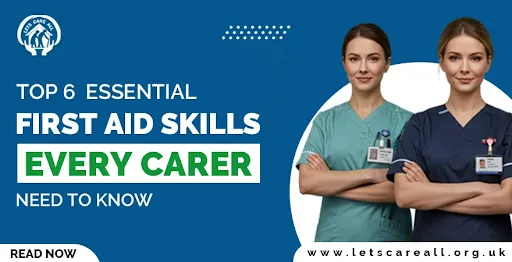- Southall, London
A call can make a DIFFERENCE
- Southall, London
A call can make a DIFFERENCE
A call can make a DIFFERENCE
Getting to Know Us!
Company Information and Customer Policies

Emergencies don’t come with a warning. If you’re a carer, you might be the first one there when something goes wrong. But here’s a serious question: Would you know what to do if someone collapsed in front of you? Confused, right. That’s why you should know the initial measures to save someone’s life in an emergency. According to British Red Cross research, just one in 20 people knows how to perform first aid. It is an alarming situation that predicts more chances of life-threatening conditions due to the lack of first aid help. That’s why you need to learn first aid skills to become an effective helper to others.
In this article, you will learn the top 6 essential first aid skills to handle medical emergencies effectively.
Emergencies are a part of life and can occur at any time, anywhere. These emergencies can be a sudden accident, bone fractures, breathing problems, or seizures. If you can not provide proper first aid care, then the injured person has a higher chance of developing a severe condition.
Now, you might wonder why first aid skills are important for carers. It’s because caregivers play a crucial role in the well-being of the people. Everyone needs first aid help in an emergency, whether they are elderly people, mentally disabled adults, or people recovering from surgery. As a caregiver, if you don’t know how to help someone in an accident, there might be a chance of their death. That’s why you should know how to act in a shocking situation.
As a carer, you need to understand the immediate actions to save someone’s life before jumping into an unexpected situation. Let’s look at these six essential first aid skills to perform the role of a better caregiver:
According to a study, there are over 30,000 out-of-hospital cardiac arrests every year in the UK. Tragically, less than one in ten people survive. It highlights the demand for immediate oxygen. CPR is a life-saving technique to help someone when their heart has stopped beating. If you have ever encountered such an emergency, be attentive and press the person’s chest to allow blood to circulate throughout the body.
You can help keep someone alive by manually pumping their blood through chest compressions, combined with rescue breaths to keep their blood oxygenated. Then, place the heel of one hand in the centre of the person’s chest, and put your other hand on top, interlocking your fingers. Push the chest down firmly about 5 to 6 cm with your arms straight, at a steady pace. Repeat this 30 times.
Next, give 2 rescue breaths. Gently tilt the person’s head back and lift their chin to open the airway. Then pinch their nose shut to make a complete seal over their mouth, and breathe in twice. Each breath should last about one second, allowing the chest to rise. You have to repeat 30 chest compressions followed by 2 rescue breaths until emergency help arrives or the person starts breathing again.
Imagine if a person gets a knife cut on their hand and starts bleeding, would you know how to stop the bleeding? As a caregiver, you don’t need to lose your mind and take proactive measures to stop the bleeding. You need to apply direct pressure to a cut using an absorbent cloth, such as a towel, to stop the bleeding. Bandage the wound tightly once the bleeding has slowed, but ensure that blood circulation is not restricted. Also, carefully inspect the wound for signs of infection. However, immediately go for a medical check-up if the wound requires stitches.
Have you ever seen someone get panicked while choking on food? Shockingly, it is a life-threatening condition. Choking happens when a piece of bread or a meal gets stuck in a person’s throat and they can’t breathe. As a carer, you should be aware of the abdominal thrust technique and how to assist someone who is choking. First aid training will enable you to implement the skills and save others’ lives. If the person can talk and cough, then refrain from interfering with their attempts to clear their throat.
You need to act quickly in case of constant choking. Stand behind the person and wrap your arms around their waist, making a fist and placing it just above their belly button. Then grab your fist with your other hand and give up to five quick, upward abdominal thrusts. Check to see if the object comes out. Try giving them five firm back blows between their shoulder blades if they’re still choking. You can alternatively give five back blows and five abdominal thrusts until the blockage is cleared and they can breathe again.
As a caregiver, you have noticed that older adults are more vulnerable to falls due to immobility. You need to be careful and attentive in such situations. Call for medical help if the person becomes unconscious after a fall. Do not let that person move in case of bone fractures or spinal cord injury; otherwise, it can worsen the injury. Apply an ice pack to the injured area for 10 minutes and carefully observe the condition for the next 24 hours. Go for medical help if you suspect any signs of a serious injury.
Burns can become severe because they can lead to severe blistering and infections. As a responsible caregiver, you should be aware of the potential consequences of these wounds. Consult a medical professional if a person experiences large-area burns caused by chemicals or electricity. However, in the case of minor burns, you can provide first aid to soothe the pain.
Imagine if a person catches fire on their clothes, ask them to stop moving and roll on the ground repeatedly. You can run cool water over the affected area for 10 to 15 minutes to soothe the skin for superficial burns. Apply a non-adhesive dressing after the burn has cooled.
A stroke occurs when blood flow to the brain is blocked or stopped. It can lead to paralysis and speech issues. You can easily help your client to recover quickly if you recognise the signs and symptoms. The acronym FAST helps you to remember what to look for when understanding stroke :
On the other hand, seizures are more frightening, but you can help an injured person with first aid skills. So, what should you do if your patient suddenly collapses and starts shaking? Place that person on the side to prevent choking and ensure the area around them is safe by removing any sharp or hazardous objects. Do not restrict their movements or put anything in their mouth. Consult a medical professional if the seizures last more than 5 minutes.
First aid skills not only give immediate assistance but also increase the chances of survival. As a responsible carer, you should know how to act attentively in a shocking scenario. You need to stay calm and take action carefully. When you understand the top 6 essential first aid skills, you are better equipped to cope with different situations according to their demands.
